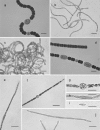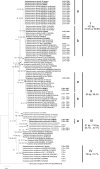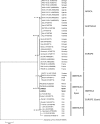Phylogeography of cylindrospermopsin and paralytic shellfish toxin-producing nostocales cyanobacteria from mediterranean europe (Spain)
- PMID: 24334673
- PMCID: PMC3911061
- DOI: 10.1128/AEM.03002-13
Phylogeography of cylindrospermopsin and paralytic shellfish toxin-producing nostocales cyanobacteria from mediterranean europe (Spain)
Abstract
Planktonic Nostocales cyanobacteria represent a challenge for microbiological research because of the wide range of cyanotoxins that they synthesize and their invasive behavior, which is presumably enhanced by global warming. To gain insight into the phylogeography of potentially toxic Nostocales from Mediterranean Europe, 31 strains of Anabaena (Anabaena crassa, A. lemmermannii, A. mendotae, and A. planctonica), Aphanizomenon (Aphanizomenon gracile, A. ovalisporum), and Cylindrospermopsis raciborskii were isolated from 14 freshwater bodies in Spain and polyphasically analyzed for their phylogeography, cyanotoxin production, and the presence of cyanotoxin biosynthesis genes. The potent cytotoxin cylindrospermopsin (CYN) was produced by all 6 Aphanizomenon ovalisporum strains at high levels (5.7 to 9.1 μg CYN mg(-1) [dry weight]) with low variation between strains (1.5 to 3.9-fold) and a marked extracellular release (19 to 41% dissolved CYN) during exponential growth. Paralytic shellfish poisoning (PSP) neurotoxins (saxitoxin, neosaxitoxin, and decarbamoylsaxitoxin) were detected in 2 Aphanizomenon gracile strains, both containing the sxtA gene. This gene was also amplified in non-PSP toxin-producing Aphanizomenon gracile and Aphanizomenon ovalisporum. Phylogenetic analyses supported the species identification and confirmed the high similarity of Spanish Anabaena and Aphanizomenon strains with other European strains. In contrast, Cylindrospermopsis raciborskii from Spain grouped together with American strains and was clearly separate from the rest of the European strains, raising questions about the current assumptions of the phylogeography and spreading routes of C. raciborskii. The present study confirms that the nostocalean genus Aphanizomenon is a major source of CYN and PSP toxins in Europe and demonstrates the presence of the sxtA gene in CYN-producing Aphanizomenon ovalisporum.
Figures




Similar articles
-
Paralytic shellfish poisoning toxin-producing cyanobacterium Aphanizomenon gracile in northeast Germany.Appl Environ Microbiol. 2010 Feb;76(4):1173-80. doi: 10.1128/AEM.02285-09. Epub 2010 Jan 4. Appl Environ Microbiol. 2010. PMID: 20048055 Free PMC article.
-
Aphanizomenon gracile (Nostocales), a cylindrospermopsin-producing cyanobacterium in Polish lakes.Environ Sci Pollut Res Int. 2013 Aug;20(8):5243-64. doi: 10.1007/s11356-012-1426-7. Epub 2013 Feb 2. Environ Sci Pollut Res Int. 2013. PMID: 23378259 Free PMC article.
-
Investigation of toxin content in Cylindrospermopsis raciborski (Wołoszyńska) Seenaya and Subba Raju and Aphanizomenon ovalisporum (Forti) strains isolated from shallow lakes of Hungary.Acta Biol Hung. 2010;61 Suppl:218-25. doi: 10.1556/ABiol.61.2010.Suppl.21. Acta Biol Hung. 2010. PMID: 21565779
-
A review of the phylogeny, ecology and toxin production of bloom-forming Aphanizomenon spp. and related species within the Nostocales (cyanobacteria).Harmful Algae. 2016 Apr;54:21-43. doi: 10.1016/j.hal.2015.09.007. Harmful Algae. 2016. PMID: 28073477 Review.
-
In search of environmental role of cylindrospermopsin: a review on global distribution and ecology of its producers.Water Res. 2014 Dec 1;66:320-337. doi: 10.1016/j.watres.2014.08.029. Epub 2014 Sep 3. Water Res. 2014. PMID: 25222334 Review.
Cited by
-
Cylindrospermopsin- and Deoxycylindrospermopsin-Producing Raphidiopsis raciborskii and Microcystin-Producing Microcystis spp. in Meiktila Lake, Myanmar.Toxins (Basel). 2020 Apr 7;12(4):232. doi: 10.3390/toxins12040232. Toxins (Basel). 2020. PMID: 32272622 Free PMC article.
-
Variability in the sxt Gene Clusters of PSP Toxin Producing Aphanizomenon gracile Strains from Norway, Spain, Germany and North America.PLoS One. 2016 Dec 1;11(12):e0167552. doi: 10.1371/journal.pone.0167552. eCollection 2016. PLoS One. 2016. PMID: 27907126 Free PMC article.
-
Temperature Influences the Production and Transport of Saxitoxin and the Expression of sxt Genes in the Cyanobacterium Aphanizomenon gracile.Toxins (Basel). 2017 Oct 13;9(10):322. doi: 10.3390/toxins9100322. Toxins (Basel). 2017. PMID: 29027918 Free PMC article.
-
Use of three monitoring approaches to manage a major Chrysosporum ovalisporum bloom in the Murray River, Australia, 2016.Environ Monit Assess. 2017 Apr;189(4):202. doi: 10.1007/s10661-017-5916-4. Epub 2017 Mar 31. Environ Monit Assess. 2017. PMID: 28364328
-
Toxicity at the Edge of Life: A Review on Cyanobacterial Toxins from Extreme Environments.Mar Drugs. 2017 Jul 24;15(7):233. doi: 10.3390/md15070233. Mar Drugs. 2017. PMID: 28737704 Free PMC article. Review.
References
-
- Sivonen K, Jones G. 1999. Cyanobacterial toxins, p 41–111 In Chorus I, Bartram J. (ed), Toxic cyanobacteria in water: a guide to public health consequences, monitoring and management. E & FN Spon, London, United Kingdom
-
- Mehnert G, Leunert F, Cires S, Johnk KD, Rucker J, Nixdorf B, Wiedner C. 2010. Competitiveness of invasive and native cyanobacteria from temperate freshwaters under various light and temperature conditions. J. Plankton Res. 32:1009–1021. 10.1093/plankt/fbq033 - DOI
-
- Ohtani I, Moore RE, Runnegar MTC. 1992. Cylindrospermopsin—a potent hepatotoxin from the blue-green alga Cylindrospermopsis raciborskii. J. Am. Chem. Soc. 114:7941–7942. 10.1021/ja00046a067 - DOI
Publication types
MeSH terms
Substances
Associated data
- Actions
- Actions
- Actions
- Actions
- Actions
- Actions
- Actions
- Actions
- Actions
- Actions
- Actions
- Actions
- Actions
- Actions
- Actions
- Actions
- Actions
- Actions
- Actions
- Actions
- Actions
- Actions
- Actions
- Actions
- Actions
- Actions
- Actions
- Actions
- Actions
- Actions
- Actions
- Actions
- Actions
- Actions
- Actions
- Actions
- Actions
- Actions
- Actions
LinkOut - more resources
Full Text Sources
Other Literature Sources
Miscellaneous

